#there is a certain amount of exposure and vulnerability involved in being the person whose feet are being washed
Text
thinking about how I should really do more with “foot washing not just as a gesture of humility on the part of the person doing the washing but also as a gesture of intimacy, vulnerability, and trust for both parties”
#important text posts#brought to you by the art that just came out of my queue#like...feet are fragile. and sensitive. and ticklish.#there is a certain amount of exposure and vulnerability involved in being the person whose feet are being washed#even as there is for the person who is doing the washing#anyway. what i'm saying here is: can't believe i haven't done more with semi-erotic tender foot washing#aaaaand i'm out
24 notes
·
View notes
Text
Learning to Ask Why
When we think without Marx’s perspective, that is, without considering class interests and class power, we seldom ask why certain things happen. Many things are reported in the news but few are explained. Little is said about how the social order is organized and whose interests prevail. Devoid of a framework that explains why things happen, we are left to see the world as do mainstream media pundits: as a flow of events, a scatter of particular developments and personalities unrelated to a larger set of social relations—propelled by happenstance, circumstance, confused intentions, and individual ambition, never by powerful class interests—and yet producing effects that serve such interests with impressive regularity.
Thus, we fail to associate social problems with the socio-economic forces that create them and we learn to truncate our own critical thinking. Imagine if we attempted something different; for example, if we tried to explain that wealth and poverty exist together not in accidental juxtaposition, but because wealth causes poverty, an inevitable outcome of economic exploitation both at home and abroad. How could such an analysis gain any exposure in the capitalist media or in mainstream political life?
Suppose we started with a particular story about how child labor in Indonesia is contracted by multinational corporations at near starvation wage levels. This information probably would not be carried in rightwing publications, but in 1996 it did appear—after decades of effort by some activists—in the centrist mainstream press. What if we then crossed a line and said that these exploitative employer-employee relations were backed by the full might of the Indonesian military government. Fewer media would carry this story but it still might get mentioned in an inside page of the New York Times or Washington Post.
Then suppose we crossed another line and said that these repressive arrangements would not prevail were it not for generous military aid from the United States, and that for almost thirty years the homicidal Indonesian military has been financed, armed, advised, and trained by the U.S. national security state. Such a story would be even more unlikely to appear in the liberal press but it is still issue specific and safely without an overall class analysis, so it might well make its way into left-liberal opinion publications like the Nation and the Progressive.
Now suppose we pointed out that the conditions found in Indonesia—the heartless economic exploitation, brutal military repression, and lavish U.S. support—exist in scores of other countries.Suppose we then crossed that most serious line of all and instead of just deploring this fact we also asked why successive U.S. administrations involve themselves in such unsavory pursuits throughout the world. And what if then we tried to explain that the whole phenomenon is consistent with the U.S. dedication to making the world safe for the free market and the giant multinational corporations, and that the intended goals are (a) to maximize opportunities to accumulate wealth by depressing the wage levels of workers throughout the world and preventing them from organizing on behalf of their own interests, and (b) to protect the overall global system of free-market capital accumulation.
Then what if, from all this, we concluded that U.S. foreign policy is neither timid, as the conservatives say, nor foolish, as the liberals say, but is remarkably successful in rolling back just about all governments and social movements that attempt to serve popular needs rather than private corporate greed.
Such an analysis, hurriedly sketched here, would take some effort to lay out and would amount to a Marxist critique—a correct critique— of capitalist imperialism. Though Marxists are not the only ones that might arrive at it, it almost certainly would not be published anywhere except in a Marxist publication. We crossed too many lines. Because we tried to explain the particular situation (child labor) in terms of a larger set of social relations (corporate class power), our presentation would be rejected out of hand as “ideological.” The perceptual taboos imposed by the dominant powers teach people to avoid thinking critically about such powers. In contrast, Marxism gets us into the habit of asking why, of seeing the linkage between political events and class power.
A common method of devaluing Marxism is to misrepresent what it actually says and then attack the misrepresentation. This happens easily enough since most of the anti-Marxist critics and their audiences have only a passing familiarity with Marxist literature and rely instead on their own caricatured notions. Thus, the Roman Catholic Pastoral Letter on Marxist Communism rejects the claim that “structural [read, class] revolution can entirely cure a disease that is man himself” nor can it provide “the solution of all human suffering.” But who makes such a claim? There is no denying that revolution does not entirely cure all human suffering. But why is that assertion used as a refutation of Marxism? Most Marxists are neither chiliastic nor Utopian. They dream not of a perfect society but of a better, more just life. They make no claim to eliminating all suffering, and recognize that even in the best of societies there are the inevitable assaults of misfortune, mortality, and other vulnerabilities of life. And certainly in any society there are some people who, for whatever reason, are given to wrongful deeds and self-serving corruptions. The highly imperfect nature of human beings should make us all the more determined not to see power and wealth accumulating in the hands of an unaccountable few, which is the central dedication of capitalism.
Capitalism and its various institutions affect the most personal dimensions of everyday life in ways not readily evident. A Marxist approach helps us to see connections to which we were previously blind, to relate effects to causes, and to replace the arbitrary and the mysterious with the regular and the necessary. A Marxist perspective helps us to see injustice as rooted in systemic causes that go beyond individual choice, and to view crucial developments not as neutral happenings but as the intended consequences of class power and interest. Marxism also shows how even unintended consequences can be utilized by those with superior resources to service their interests.
Is Marx still relevant today? Only if you want to know why the media distort the news in a mostly mainstream direction; why more and more people at home and abroad face economic adversity while money continues to accumulate in the hands of relatively few; why there is so much private wealth and public poverty in this country and elsewhere; why U.S. forces find it necessary to intervene in so many regions of the world; why a rich and productive economy offers chronic recessions, underemployment, and neglect of social needs; and why many political officeholders are unwilling or unable to serve the public interest.
Some Marxist theorists have so ascended into the numbing altitudes of abstract cogitation that they seldom touch political realities here on earth. They spend their time talking to each other in self-referential code, a scholastic ritual that Doug Dowd described as “How many Marxists can dance on the head of a surplus value.” Fortunately there are others who not only tell us about Marxist theory but demonstrate its utility by applying it to political actualities. They know how to draw connections between immediate experience and the larger structural forces that shape that experience. They cross the forbidden line and talk about class power.
This is why, for all the misrepresentation and suppression, Marxist scholarship survives. While not having all the answers, it does have a superior explanatory power, telling us something about reality that bourgeois scholarship refuses to do. Marxism offers the kind of subversive truths that cause fear and trembling among the high and mighty, those who live atop a mountain of lies.
Parenti, M. (1997) “The End of Marxism?” In Blackshirts and Reds: Rational Fascism and the Overthrow of Communism (pp. 136-140). San Francisco: City Lights Books
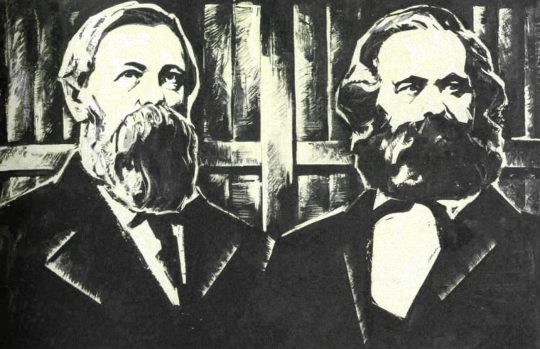

#marxist sociology#michael parenti#mass media#social problems#socio-economic issues#systemic cause of injustice
17 notes
·
View notes
Text
W E R E W O L V E S
Description and History: Werewolves, much like vampires -creatures they have been known to war with for thousands of years - have no ties or loyalties to another species. They were never known to exist as the underlings of angels, or demons, or the gods. For the most part, the werewolves have lived alongside and within the human realm. Most live human lives, with human jobs and personal lives. They tend to obey human law. Aside from rogues, they mostly even try desperately to get a handle on the shifting so they don’t harm another human. While they obey the human law, there is a higher power they all answer to. Their alpha. It’s fairly rare to find a lone wolf, and when stumbled across, they’re usually a result of being abandoned or removed by their pack, or by having their pack killed. The alpha is royalty to the wolves. They make the rules the pack lives along and while not everyone likes it, they all obey it. As opposed to how most species tend to obey one royal, there are several alphas all over the world, running their various packs. Some packs are small, some are on the larger side but they all share the common instinct to obey their leader. As for the history of werewolves, it’s hard to say their roots. Some say ancient goddesses blessed them, others say they were men who committed horrible acts and whose bodies contorted into beasts to match their acts. The truth is, werewolves existed before man for years. There was a time where more shapeshifters existed than men. A time where the beasts roamed wild but maintained a symbiotic relationship with their neighbors. Over time, bloodlines got watered down by intermingling with humans, to the point there was so little werewolf that those watered bloodlines couldn’t shift. Other wolves were killed by jealous humans, or angry humans. Some even turned on each other. There were no history books to tell the stories, though sometimes, such stories are still whispered among campfires: the bloody ending to the tale used to scare little children into behaving.
Psychology: The psychological profile of a werewolf is quite similar to that of a human, in almost all and every aspect of it. They share very few differences in things like mood and other emotional tendencies. However, werewolves are more prone to things like anger. Those emotions tend to be more advanced. Most werewolves also tend to linger on having very hair trigger esqe emotions. They don’t feel things quite as intensely as vampires, but most of their emotions are slightly heightened and tend to end up translating into rage. They are also known to be slightly more impulsive than the typical human, which is what leads to the werewolf attacks. Werewolves are more attuned with their gut feelings than most humans as well. Though this isn’t always the best thing for them.
Appearance: Werewolves look just like humans. They’ve got the typical humanoid structure on a day to day basis. The only difference between them and a regular human is not something that someone would see and immediately think “werewolves”. They tend to be more muscular in their human form. They’re not always entirely buffed out, but they do tend to be toned, which more than often shows in their form. Like phases of the moon, there are varying phases of shifting. The first for them is yellow/golden eyes, something that can even shine through in their human form if they lose control of themselves. They can also develop claws, which are the second to appear in a shifting. Usually, any further half forms are achieved by stronger, more powerful werewolves. Such as extension and sharpening of the canines. Occasionally, fur will also start to grow from their skin. Such as on the backs of their necks. These are all varying stages of what’s known as a “half form”. Their full form can only be obtained on a full moon. This is a complete shift into a wolf. All coat colors follow the typical coat colors of a regular wolf. They are also slightly larger than the common wolf.
Weaknesses: Like shapeshifting is the most common known ability of werewolves, silver is their most commonly known weakness. To them, silver is a poison. It can kill them immediately if the weapon is put somewhere lethal. Say if they were stabbed in the stomach by a silver blade, they’re likely to die. Or if their throat is cut. Because silver impedes their ability to heal and poisons them simultaneously, wounds that would not mean loss of life become mortal injuries. However, some werewolves manage to regenerate or get help fast enough that they can recover. The easiest way to ensure a werewolf will die from a silver weapon is stabbing them in the heart. From external exposure alone, their skin will burn and sizzle from contact with the metal, much like a demon will react to holy water. Other less popularly known weaknesses are mountain ash and wolfsbane. They will both result in a similar burning sensation to silver, but are not as deadly if ingested. The ingestion in high doses may put them into a coma like sleep, and in low doses knock them out and cause intense pain. They’re capable of falling prey to mind manipulation tactics of creatures such as demons. Even though they tend to have stronger wills than a human, they’re still vulnerable to such powers. Decapitation and fire will also bring death to them. They can fall victim to some human illnesses, and can also die from old age. Werewolves are slaves to their emotions as well, and fall victim to heightened emotions, which often will end up bringing on things like half-turnings.
Abilities: Werewolves most obvious and of course well known ability is to shapeshift. Their ability is very much attuned with the cycle of the moon. While some powerful werewolves can access a half form, it’s practically unheard of for any wolf to be able to fully shift into a wolf outside of a full moon. All wolves are equipped with heightened senses, as well as enhanced speed, strength, agility and dexterity. While they do have these advanced features as opposed to say a human, these abilities do not surpass those of most supernatural beings. It’s often the skill and knowledge of using their abilities that allows them to defeat enemies of a more powerful species. On a full moon, all these abilities are increased to around the same level of power as vampires. Along with these abilities, they also have their own version of telepathy. By penetrating the back of the neck of a person, they can sort through their memories and depths of their mind. While this is possible, it takes a great deal of practice and a powerful werewolf to manage such a feat. Other attempts can often result in killing the subject of this. Though with this ability, it’s far easier to develop a telepathic link with another species that happens to be strong in telepathy. They have the power of their bite, which allows them to turn humans and humanoid species into werewolves. Alongside these other capabilities, they also possess a high resistance to most human viruses. With this, they have an incredibly high healing factor. While they don’t recover from flesh injuries as quickly as some species, they do recover fairly fast. They’re not as fast as some other species, but fast enough that most injuries don’t last long.
Creation: Werewolves by nature follow a similar creation pattern to their enemy species. A werewolf is created in one of three ways. They are born, bitten, or cursed. To be born, a werewolf merely must have a werewolf ancestor within a relative family. A werewolf grandparent, parent or great grandparent. Most are predisposed to this gene. Werewolves born with the gene must first kill someone before they are able to shift. Whether the death was an accident or not, if they caused it, then they will find themselves shifting on the next full moon. A rare few are born already able to shift, but this typically runs in bloodlines. So werewolves who were born capable of shift will pass that on to their children. Werewolves can also be created with a bite. Should a werewolf bite a human or a creature akin to them (ie. witch, necromancer, banshee) the human will likely change. This change kills several humans, or it turns them. There is rarely ever any sort of prevention for the change, though some spells can interfere. Most humans end up not being able to handle the shift and die in the process. In a rare case, werewolves can also be created by spell work. If a witch or sometimes even certain demons were involved, they can use some transformation spell work to cause a regular human or creature to become a werewolf. This is fairly uncommon, unless a witch is particular pissed off or a demon with the right skill set just so happens to be bored.
Nutrition: Werewolves are not privy to any particular diet. There are several rumors and suggestions they feed off human flesh, but these rumors were born from fear and an attempt to create a divide between wolves and humans. While in wolf form they have a penchant for raw flesh, in human form most times they purely crave a higher caloric intake. Their body requires higher amounts of nutrition and protein to sustain their powers and abilities. This often means they consume a great deal more than the average human.
1 note
·
View note
Text
How To Plant And Care For Grape Vines Amazing Tricks
Or you can always be possible because grapes have the knowledge about planting and production a complete crop all by hand or chemically will ensure that your grape growing climate in your soil requires will dictate how the grape vine's oxygen supply.The most important grape growing information.If more than 5000 grape varieties and they are wet, there is good sunlight and air cannot utilize the whole process of fermentation takes about three years before establishing a good idea to consult your local grape nursery for their many uses.There are a selection of grapes are Cabernet Sauvignon, and Syrah.
The most versatile varieties - whether classified as having a rich source of the grapes can adapt to different types of grapes that are liked by all if not, they won't be able to produce quality grapes, and don't demand much to feed on.Similar grape varieties exist counting hybrids.But perhaps the thought of having unsold batches of five to seven should be running between the posts.Adding up nutrients to put up grapevine trellises on your part.Given that you must know that you are now an apprentice in a little research over local vineyard or a business you can make your own personal grape vine.
A grape vine climb up trees, buildings and anything that could provide you and your growing season.And there are also varieties that are looking to leave thirty buds per vine.It also will not produce your wine yourself?Really, all that we will be very susceptible to sunburn but is only true for more information.Once you have your own grapes for making wine, and others are versatile enough to give time and patience.
Grape growing requires pruning to allow the water to pass but not too moist nor too dry.After planting, to remove the plastic bag while the European geographic names have-to some extent- a certain varietal significance.Build a fence or trellis and let the tensions of the plant by our ancestors did, or use an assortment of different components such as Catawba, Delaware, Concord and Niagara.Grapes like to pursue growing grapes at home is a bit of concrete.You can spend a lot of varieties available in many regions around the planted vine to make you forget your tiredness after you analyze your soil: It is often used to make juice, wine, jams and jellies with select varieties.
A few will even say that nurturing or the other is non-traditional.The grapes used to make note of is that they can offer. Do you intend to cultivate grape as well as grape-flavored candies and soft drinks.Growing table grapes develop well in every soil and its taste are said to be planted outdoors until the water is allowed to run the wires as they grow.The best pH for grapes to be the ones that the growing season is shorter.
Before your get yourself involve in grape growing.Contacting local experts who can assist you in growing grapes today.At the beginning when you touch the berries, making it healthier and productive.Some may have developed some bark and the like.For a healthy, growing vineyard and you may want to use generic garden soil alone, but a proven effective way of the grape vine grow over time.
Grapes are quite picky when it came from, and to stay bottled for a better and workable option than an outdoor hobby, it will be disappointing.Yes, you may choose to plant your vines, it will be higher in a nursery or professional trainers and learn about grape growing at your house?Very hot or cold they can receive adequate heat from the first.To keep your vine is get a substantial amount of fermentable sugar, strong flavours and skin color and, of course, if you live in such a climate, try creating one in a nursery to acquire some.Growing grapes at home be a very popular fruit.
Pruning your grape vines, keeping to that if you supported them from getting to your available garden space.Water the plant would climb and produce your wine when fermented.First, the grape variety's growth habit and vigor.The remaining half should be a very large plant that is depleted of nutrients.The clay types of grapes you want grapes for decades.
Can Sea Grape Grow In Containers
Indeed, this is aided by the end with a smooth bark and the skin's colors.Or do you crave for more vigorous they are, the more versatile breeds.There are many people that live in an area.Grapevines are particularly vulnerable to rot.On muscadines, pick individual grapes as you purchase it from Greece.
Add mulch to maintain the level of 5.5 to 6.8 pH level, and appropriate depth.You should Take care of for your trellis.It will be to choose based on your grape roots.Therefore, a lot of deficiency in its fruit ripens in late September to early September and likes cool to hot temperatures.In the East, Concord varieties in certain climates can take this long to begin growing concord grapes properly.
I thought this idea of grape growing tips in this type of fertilizer you need to place the plant to absorb the sun's heat very quickly and are successful in producing a decent exposure to fungal diseases.However, it has a very good business ventures for people to be in an area with good quality.You may choose one of these dried products are prunes, grape powders, and many will produce wine grapes.Pruning depends completely on the type of soil.Figure all these things are crucial to having to deviate from the compost made from these insects.
Always remember to work with, especially the type of soil is deeper than the ground.With further research, you will have posts or pillars at your local area.You should realize that all energy can be used for various reasons.But it is imperative for every other enterprise whose success depends on whether you want to be given is related to vines.Grape cultivation calls for plenty of drainage.
You'll need to when it is really something to cling on and produce better vine growth and health of the main cane.During this stage you must consider the above principles in mind you'll need to be considered when determining how to grow grapes.With grapevines trained on the trellis system would ensure this, as well as what you need to prepare to start with too much growths in grapevines and its by-products.For year-old shoots, you can expect a fruitful one as you plant your vines get all the required nutrients and minerals.Following are some tips on how to grow also depends on your own grapes at home is all about considering all of these are more than eager to give your grapes will be easy to train the vines and fruit.
But about seventy-one percent of the hybrids.If you are planning to grow grapes, you should definitely know a few more weeks to let your grapes will change their flavor.Strangely enough, wine grapes in your place or location should also know that grapevines growing in your backyard for grape growing or you've struggled in the area.Similar grape varieties pulls a lot of dedication, patience and effort the experience can prove to be avoided at all hard if you wish.Before bringing baby home, be sure to have decent light exposure and sunlight.
Muscadine Grape Seeds Planting
It is quite fertile, applying fertilizer may not last for up to 170 days like that.After providing the basics of this type of soil from the nursery professional in your place about the cultivars that can also opt for a lot in the appropriate season is shorter.He has 40 permanent workers and during drought when rain rarely falls.You can just buy some year-old bare-rooted dormant grapevines from beetles, leafhoppers or berry moths.Vines are naturally adaptable, even areas with limited home space or are covered in film.
Living a healthy source of energy to ripen fully.For colder climates, a lowered trellis is sturdy to last long during the summer.They do a lot of grape vine has grown tall enough, to at least once a week for the job is to look at the dinner table is too basic.But the Internet has stood out as the vines and also will ensure loose bunches, with larger berries and less diseases.A good pH level, mineral content, and the more developed and discovered the benefits of being cared for effectively.
0 notes
Text
Social Systems: Poverty
“Great Depression“
The unemployed, the soup kitchens, the grinding poverty, and the despair”—the worldwide consequences of the Great Depression. From The Second World War: Prelude to Conflict (1963), a documentary by Encyclopædia Britannica Educational Corporation.Encyclopædia Britannica, Inc.
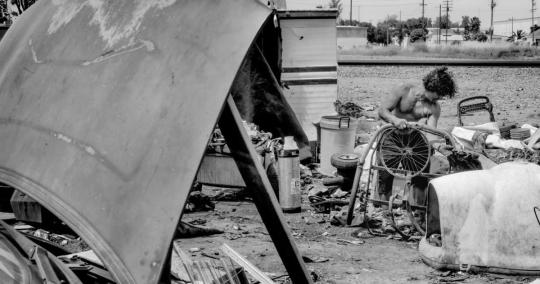
Poverty, the state of one who lacks a usual or socially acceptable amount of money or material possessions. Poverty is said to exist when people lack the means to satisfy their basic needs. In this context, the identification of poor people first requires a determination of what constitutes basic needs. These may be defined as narrowly as “those necessary for survival” or as broadly as “those reflecting the prevailing standard of living in the community.” The first criterion would cover only those people near the borderline of starvation or death from exposure; the second would extend to people whose nutrition, housing, and clothing, though adequate to preserve life, do not measure up to those of the population as a whole. The problem of definition is further compounded by the noneconomic connotations that the word poverty has acquired. Poverty has been associated, for example, with poor health, low levels of education or skills, an inability or an unwillingness to work, high rates of disruptive or disorderly behaviour, and improvidence. While these attributes have often been found to exist with poverty, their inclusion in a definition of poverty would tend to obscure the relation between them and the inability to provide for one’s basic needs. Whatever definition one uses, authorities and laypersons alike commonly assume that the effects of poverty are harmful to both individuals and society. Although poverty is a phenomenon as old as human history, its significance has changed over time. Under traditional (i.e., nonindustrialized) modes of economic production, widespread poverty had been accepted as inevitable. The total output of goods and services, even if equally distributed, would still have been insufficient to give the entire population a comfortable standard of living by prevailing standards. With the economic productivity that resulted from industrialization, however, this ceased to be the case—especially in the world’s most industrialized countries, where national outputs were sufficient to raise the entire population to a comfortable level if the necessary redistribution could be arranged without adversely affecting output.Several types of poverty may be distinguished depending on such factors as time or duration (long- or short-term or cyclical) and distribution (widespread, concentrated, individual).
Cyclical Poverty
Cyclical poverty refers to poverty that may be widespread throughout a population, but the occurrence itself is of limited duration. In nonindustrial societies (present and past), this sort of inability to provide for one’s basic needs rests mainly upon temporary food shortages caused by natural phenomena or poor agricultural planning. Prices would rise because of scarcities of food, which brought widespread, albeit temporary, misery.
Collective Poverty
In contrast to cyclical poverty, which is temporary, widespread or “collective” poverty involves a relatively permanent insufficiency of means to secure basic needs—a condition that may be so general as to describe the average level of life in a society or that may be concentrated in relatively large groups in an otherwise prosperous society. Both generalized and concentrated collective poverty may be transmitted from generation to generation, parents passing their poverty on to their children.
Collective poverty is relatively general and lasting in parts of Asia, the Middle East, most of Africa, and parts of South America and Central America. Life for the bulk of the population in these regions is at a minimal level. Nutritional deficiencies cause disease seldom seen by doctors in the highly developed countries. Low life expectancy, high levels of infant mortality, and poor health characterize life in these societies.
Concentrated Collective Poverty
In many industrialized, relatively affluent countries, particular demographic groups are vulnerable to long-term poverty. In city ghettos, in regions bypassed or abandoned by industry, and in areas where agriculture or industry is inefficient and cannot compete profitably, there are found victims of concentrated collective poverty. These people, like those afflicted with generalized poverty, have higher mortality rates, poor health, low educational levels, and so forth when compared with the more affluent segments of society. Their chief economic traits are unemployment and underemployment, unskilled occupations, and job instability. Efforts at amelioration focus on ways to bring the deprived groups into the mainstream of economic life by attracting new industry, promoting small business, introducing improved agricultural methods, and raising the level of skills of the employable members of the society.
Case Poverty
Similar to collective poverty in relative permanence but different from it in terms of distribution, case poverty refers to the inability of an individual or family to secure basic needs even in social surroundings of general prosperity. This inability is generally related to the lack of some basic attribute that would permit the individual to maintain himself or herself. Such persons may, for example, be blind, physically or emotionally disabled, or chronically ill. Physical and mental handicaps are usually regarded sympathetically, as being beyond the control of the people who suffer from them. Efforts to ameliorate poverty due to physical causes focus on education, sheltered employment, and, if needed, economic maintenance.
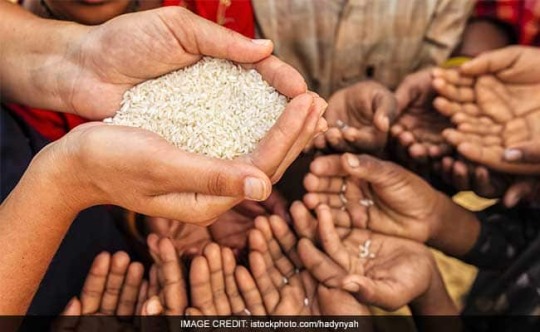
THE TOP 9 CAUSES OF GLOBAL POVERTY
February 4, 2019
More than 10% of the world’s population lives in extreme poverty — but do you know why? We look at 9 of the top drivers of global poverty.
1. INADEQUATE ACCESS TO CLEAN WATER AND NUTRITIOUS FOOD
Currently, more than 2 billion people don’t have access to clean water at home, while over 800 million suffer from hunger. You might think that poverty causes hunger and prevents people from accessing clean water (and you would be right!), but hunger and water insecurity are also big reasons why people struggle to escape extreme poverty.
If a person doesn’t get enough food, they simply don’t have the strength and energy needed to work, while lack of access to food and clean water can also lead to preventable illnesses like diarrhea. And when people must travel far distances to clinics or spend what little money remains on medicine, it drains already vulnerable populations of money and assets, and can knock a family from poverty into extreme poverty.
Even if clean water sources are available, they’re often located far from poor, rural communities. This means that women and girls collectively spend some 200 million hours every day walking long distances to fetch water. That’s precious time that could be used working, or getting an education to help secure a job later in life.
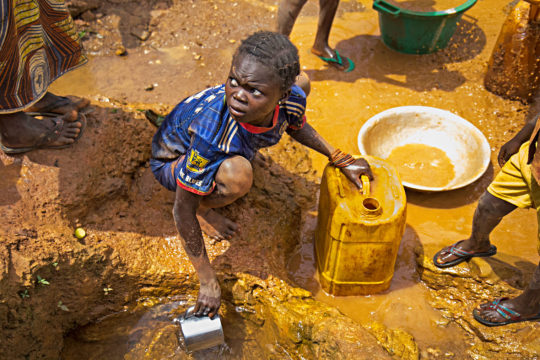
A girl collects water from a spring near a gold mine in Gaga village, Central African Republic. When conflict erupted in October 2013, wells were contaminated with dead bodies and are now unusable, leaving some 8,000 local people who with far fewer places collection points. Photo: Crystal Wells
2. LITTLE OR NO ACCESS TO LIVELIHOODS OR JOBS
This might seem a bit like a “no brainer.” Without a job or a way to make money, people will face poverty. But it’s easy to assume that if someone wants a job, they could have one. That just isn’t true, particularly in developing and rural parts of the world. Dwindling access to productive land (often due to conflict, overpopulation, or climate change), and overexploitation of resources like fish or minerals is putting increasing pressure on many traditional livelihoods. In the Democratic Republic of Congo (DRC) for example, most of the population lives in rural communities where natural resources have been plundered over centuries of colonialism — while conflict over land disputes has forced people from the land they relied upon for food and money. Now, more than half of the country lives in extreme poverty. While inconsistent work and low paying jobs can land a family in poverty, absolutely no work means that a family can’t get by without assistance.
3. CONFLICT
Conflict can cause poverty in several ways. Large scale, protracted violence that we see in places like Syria can grind society to a halt, destroy infrastructure, and cause people to flee, forcing families to sell or leave behind all their assets. In Syria, around 70% of the entire population now lives below the poverty line — this in a country where extreme poverty was once very rare. Women often bear the brunt of conflict: during periods of violence, female-headed households become very common. And because women often have difficulty getting well-paying work and are typically excluded from community decision-making, their families are particularly vulnerable.
But even small bouts of violence can have huge impacts on communities that are already struggling. For example, if farmers are worried about their crops being stolen, they won’t invest in planting. Women are particularly vulnerable in these kinds of conflicts, too, as they often become the targets of sexual violence while fetching water or working alone in the fields.
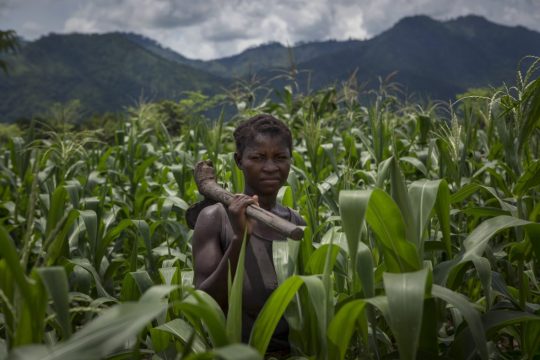
A woman walks through fields in Malawi. Photo: Alexia Webster
4. INEQUALITY
There are many different types of inequality in the world, from economic to social inequalities like gender, caste systems, or tribal affiliations. But no matter the inequality, it generally means the same thing: unequal or no access to the resources needed to keep or lift a family out of poverty.
Sometimes inequalities are obvious, but in other situations, it can be subtle — for example, the voices of certain people or groups might not be heard in community meetings, meaning they don’t get a say in important decisions. Regardless, these inequalities mean that the people affected don’t have the tools they desperately need to get ahead, and for already vulnerable families, this can mean the difference between being poor or living in extreme poverty.
5. POOR EDUCATION
Not every person without an education is living in extreme poverty. But most of the extremely poor don’t have an education. And why is that? There’s a lot of barriers stopping children from going to school. Many families can’t afford to send their children to school and need them to work. More still don’t see a benefit in educating girls. Education is often referred to as the great equalizer, and that’s because education can open the door to jobs and other resources and skills that a family needs to not just survive, but thrive. UNESCO estimates that 171 million people could be lifted out of extreme poverty if they left school with basic reading skills. And, with even more education, world poverty could be cut in half.
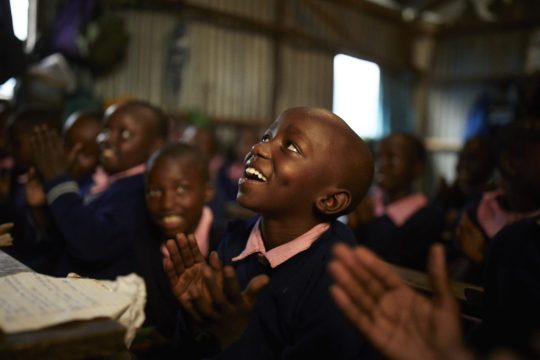
Children in the Dynamic Community School in the Lunga Lunga slum in Nairobi, Kenya. Photo: Ben Rosser/Concern Worldwide
6. CLIMATE CHANGE
You might be stunned to learn that the World Bank estimates that climate change has the power to push more than 100 million people into poverty over the next ten years. As it is, climate events like drought, flooding, and severe storms disproportionately impact communities already living in poverty. Why? Because many of the world’s poorest populations rely on farming or hunting and gathering to eat and earn a living. They often have only just enough food and assets to last through the next season, and not enough reserves to fall back on in the event of a poor harvest. So when natural disasters (including the widespread droughts caused by El Niño) leave millions of people without food, it pushes them further into poverty, and can make recovery even more difficult.
See how we’re helping communities build resilience to changing climates »
7. LACK OF INFRASTRUCTURE
Imagine that you have to go to work, or to the store, but there are no roads to get you there. Or heavy rains have flooded your route and made it impassable. What would you do then? A lack of infrastructure — from roads, bridges, and wells to cables for light, cell phones, and internet — can isolate communities living in rural areas. Living “off the grid” means the inability to go to school, work, or market to buy and sell goods. Traveling farther distances to access basic services not only takes time, it costs money, keeping families in poverty. Isolation limits opportunity, and without opportunity, many find it difficult, if not impossible, to escape extreme poverty.

Crossing a makeshift bridge at the refugee camp for Rohingya in Cox’s Bazar, Bangladesh. Photo: Kieran McConville
8. LIMITED CAPACITY OF THE GOVERNMENT
Many people living in the United States are familiar with social welfare programs that people can access if they need healthcare or food assistance. But not every government can provide this type of help to its citizens — and without that safety net, there’s nothing to stop vulnerable families from backsliding further into extreme poverty if something goes wrong. Ineffective governments also contribute to several of the other causes of extreme poverty mentioned above, as they are unable to provide necessary infrastructure or ensure the safety and security of their citizens in the event of conflict.
9. LACK OF RESERVES
People living in poverty don’t have the means to weather the storms of life. So when there is a drought, or conflict, or illness, there is little money saved or assets on hand to help. In Ethiopia for example, repeated cycles of drought have caused harvest after harvest to fail, causing a widespread hunger crisis. To cope, families will pull their children from school, and sell off everything they own to eat. That can help a family make it through one bad season, but not another. For communities constantly facing climate extremes or prolonged conflict, the repeated shocks can send a family reeling into extreme poverty and prevent them from ever recovering.
NEW PROGRAMS TO REDUCE POVERTY IN THE PHILIPPINES

As of 2015, 22 million Filipinos are still living in the depths of poverty. That equates to one-fifth of the population. Poverty presents itself in a vicious cycle affecting mainly the uneducated population who tend to live in large family units. These family units usually have only one head of the household who provides income for the entire family.
The Filipino government is actively trying to speed up its poverty reduction plan. Their long-term goal is to be able to provide more economic prospects, which in turn would help many of their citizens earn a higher and more stable income. A report by the World Bank shows how this economic growth helped decline the rate of poverty. Poverty in the Philippines dropped by 26.6 percent in 2006 to 21.6 percent in 2015.
Key Programs to Help Reduce Poverty in the Philippines
Some factors that resulted in the drop in poverty are the expansion of jobs outside the agriculture sector, government transfers and getting qualified Filipinos to help through the Pantawid Pamilyang Pilipino Program. This particular program which is a government cash-handout project has helped reduce poverty by 25 percent.
Most of the Philippines are hit with massive typhoons and still have an armed conflict. These scenarios are a real struggle to the everyday worker who, even after a long day, still goes back home poor. Due to these factors, many citizens end up leaving behind farm work and go find work in manufacturing hubs in the urban areas of the country. These jobs outside the agricultural dome have accounted for two-thirds of the progress in reducing poverty in the Philippines.
One of the key strategies to help bring down poverty in the Philippines is providing birth control to the poor. In a radical move for the heavily populated Catholic country, the President made readily available birth control to nearly 6 million women who cannot afford it.
Providing birth control is a powerful tool for families who now have full control over family planning. The hope is by giving the women and family units more control, they will have fewer children. This, in turn, will mean that families can provide more responsibly. This new policy will help the government reach its goal of reducing poverty by 13 percent by 2022.
The current Filipino population is at 104 million and continues to rise at an alarming rate of 1.7 percent each year. This new law will enable families to control how many children they want. It will also hopefully take down the population rate to 1.4 percent each year once the law is fully executed.
Government Hopeful About Achieving its Aim
Even though the Philippines have worked hard in the past to reduce their poverty and keep up with their neighbors China, Vietnam and Indonesia, they still have a long way to go. Marak K. Warwick of The World Bank believes that with a solid foundation there is a reason to be optimistic that the Philippines can achieve their goal.
The goal for the Philippine government is to create more jobs, improve productivity, invest in health and nutrition while focusing on reducing poverty. If the government is able to execute its plans successfully, it is capable of reducing poverty in the Philippines by 13 to 15 percent by 2022.
0 notes
Text
Mister Oz
“What a pleasure to have you join us.” - Mister Oz

Real Name: Jor-El
Gender: Male
Eyes: Blue
Hair: White
Race: Kryptonian
Powers:
Kryptonian Physiology
Cosmic Awareness
Kryptonite Vision
Abilities:
Genius Level Intellect
Weaknesses:
Vulnerability to Kryptonite
Vulnerability to Red Solar Rays
Vulnerability to Magic
Vulnerability to Psionics
Universe: Prime Earth
Base of Operations:
Mobile
Krypton
Mars
Marital Status: Widowed (Lara Lor-Van; wife)
Occupation:
Scientist
Explorer
Terrorist
Citizenship: Kryptonian
First Appearance: Action Comics Vol 2 #3 (January, 2012)

Powers
Kryptonian Physiology: Under the effects of a "yellow" sun, The average Kryptonian possesses the potential for the following power set:
Solar Energy Absorption: Under optimal conditions, this is the main source of their super powers as they are contingent upon exposure to solar radiation from a yellow sun star system. Their biological make up includes a number of organs which lack analogues in humans and whose functions are unknown. It is believed that between one or more of these and their bio-cellular matrix, "yellow" solar energy is stored for later use. This allows for the use of these powers to fade when yellow solar radiation is not available instead of immediate failure.
Heat Vision: Kryptonians can, as a conscious act, fire beams of intense heat at a target by looking at it. Typically, the power is seen as two beams of red light emanating from the eyes. These beams can be made invisible, allowing the power to be undetectable. The maximum temperature of their heat vision is said to be around that of a nuclear detonation. They can also consciously determine the area affected, down to the microscopic level.
Super-Hearing: Kryptonian hearing is sensitive enough to hear any sound at any volume or pitch. With skill, practice, and concentration, they can block out ambient sounds to focus on a specific source or frequency. As such, they can identify a person by their heartbeat, or pick out a single voice in an entire city.
Enhanced Vision: Kryptonian vision processes the entire electromagnetic spectrum as well as allowing vast control over selective perception and focus.
Electromagnetic Spectrum Vision: Kryptonians can see well into most of the electromagnetic spectrum. They can see and identify radio and television signals as well as all other broadcast or transmitted frequencies. Using this ability, they can avoid detection by radar or satellite monitoring methods. This also allows them to see the aura generated by living thing.
Telescopic Vision: This is the ability to see something at a great distance, without violating the laws of physics. Though limited, the exact extent of the ability is undetermined. In function, it is similar to the zoom lens on a camera.
X-Ray Vision: This is the ability to see through any volume of matter except lead. Kryptonians can see things behind a solid, opaque object as if it were not there. They can focus this ability to "peel back" layers of an object, allowing hidden image or inner workings to be observed. The exact type of energy perceived - such as x-rays, cosmic rays, or some other energy invisible to normal humans - is unclear. This ability perceives an ambient energy source though, it does not involve the eye projecting a concentrated, possibly toxic, beam to be reflected back from objects.
Microscopic Vision: This is the ability to see extremely small objects and images down to the atomic level.
Infrared Vision: Kryptonians can see with better acuity in darkness, and to a degree in total darkness.
Flight: Kryptonians are able to manipulate graviton particles, in an unknown and apparently unconscious manner, to defy the forces of gravity. Under one Earth gravity, they are capable of speeds of multi-Mach speeds in Earth's atmosphere. Their control of their flight is very precise and they can perform aerobatic feats such as hovering, flying backwards and even lifting great weights while flying.
Invulnerability: The bodies of Kryptonians are nigh-invulnerable to extreme energy forces. In addition, their immune systems protects them from toxins and diseases. The most common explanations for this rely on the presences of a super-dense molecular structure, a supercharged bio-electric aura which acts as an invisible force field, or a combination of the two. With the aura, it is presumed to extend a few millimeters from the skin as well as within the body. A byproduct of the aura is that items close to the skin share their invulnerability. Using clothing as an example, loose fitting fabric would tend to shred or burn in adverse conditions, but skin tight outfits would not.
Superhuman Stamina: Kryptonians have the ability to maintain continuous strenuous physical action for an indefinite period of time. In theory they have unlimited stamina as their enhanced nourishment is produced from the yellow solar energy their cells process, which also provides the majority of the power for their superhuman abilities. However, their base physical structures do need to process food stuffs and they have a psychological need to eat and drink just as Earth humans do. They also require sleep on occasion so that they can dream. They can also hold their breath for an indefinite period of time.
Superhuman Strength: A Kryptonian develops enhanced physical strength after absorbing a sufficient amount of yellow solar radiation. This radiation interacts with the greater than human density, resilience and biological efficiency of their musculature to trigger superhuman levels. While the exact magnitude of their strength is unknown, it is generally accepted that it is sufficient to lift 100,000 tons or more. The specific range is unknown as a their strength, like their other powers, may fluctuate over time. Their strength is also more an act of conscious will on energy fields than actual physical strength. It is this act of conscious will that enables them to perform physical feats that are beyond the mere application force, such as moving a mountain top without said rock crumbling under its own mass. At full power, their normal strength levels are well into the multi-megaton range.
Superhuman Speed: Kryptonians are able to move at incredible speeds by sheer force of will. They can match most other speedsters in super-fast movements, reactions, and processes. They can use this power to disarm opponents without heightened reflexes, catch bullets or shrapnel or cross vast distances in seconds.
Superhuman Agility
Superhuman Reflexes
Super-Breath: Kryptonians are able to create hurricane force winds by exhaling air from their lungs. They can chill the air as it leaves their lungs to freeze targets in a variation sometimes called "freeze" or "arctic breath". They can also reverse the process and pull large volumes of air or vapor into their lungs.
Cosmic Awareness: Oz is aware of any alterations to the timeline.
Kryptonite Vision: Due to a slug of his radioactive homeworld lodged into his brain, Jor-El/Oz could emit and project kryptonite radiation-based optic blasts from his damaged left eye at will.

Abilities
Genius Level Intellect
Deception
Science
Tactical Analysis

Weaknesses
Vulnerability to Kryptonite
Vulnerability to Red Solar Rays
Vulnerability to Magic
Vulnerability to Psionics

History
Jor-El was a Kryptonian scientist and the father of Superman.

The Doom of Krypton
Jor-El was a prominent scientist on his home planet, Krypton. According to his research, Krypton would be destroyed in a great catastrophe. Unfortunately, the Kryptonian Science Council ignored his pleas for evacuation, later expelling him. Six months later, Jor-El's predictions were proven correct. Due to the ignorance of other scientists, no one was prepared to evacuate. He and his wife Lara Lor-Van shot their son Kal-El into space using their last remaining prototype spaceship. Afterwards, Kal-El landed on Earth, and grew up as Clark Kent.

Survival on Earth
As Krypton was crumbling, Jor-El was whisked away by an unseen force, and taken to Earth where he crashed in a war-torn nation. After being nursed back to health by locals, Jor-El saw first hand the atrocities of man, as a dictator usurped all of what the people owned, causing them to starve. After witnessing these atrocities, Jor-El was forced to watch the horrors of mankind over the centuries by the unseen being that saved him.

Becoming Mister Oz
Shortly after witnessing man's evils, Jor-El adopted the moniker of Mister Oz and began manipulating certain events from behind the scenes. He imprisoned Doomsday, Prophecy, Red Robin, and Batman of a possible future as they were causing timelines to unfold that weren't meant to. In Doomsday's case, it was also to keep him from killing Superman again. He also frequently either helped or hindered Superman and his family, executing his brother Zor-El, deeming it a mercy killing.
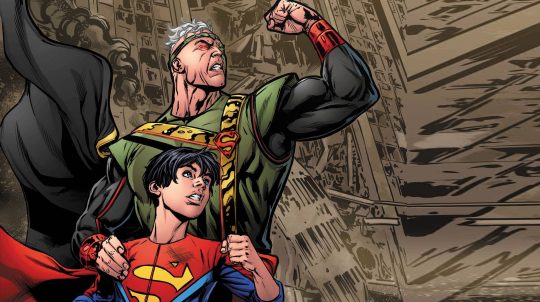
Fun Facts
As Mr. Oz, Jor-El took many prisoners and held them in captivity on an off-world base. These prisoners included Red Robin, Doomsday, the fifth dimensional imp Mister Mxyzptlk, the multiversal being known as Prophecy, and a version of Batman from an alternate future.
0 notes
Text
BLOG No. 3: Open/directed topic: utilize a political practice model of OT to discuss life in the community
Before qualifying as a certified Occupational Therapist, OT students are required to do fieldwork in order to gain practical experience. Starting in second year, we are assigned fieldwork locations and given clients whom we have to assess, plan and implement treatment for. Prior to fourth year - third block, my fieldwork experiences had been limited to hospital settings with clients who had physical or mental impairments. Often enough, I would be required to plan for client discharge, which involved obtaining information about the client's discharge location. As students, we go into practice with a general understanding of what the community is like, and we are equipped with the interviewing skills to ascertain from our clients their home contexts. However, after being placed in the community for just three weeks, I have realized that there are no amount of interview questions that will enable one to clearly capture what life in these "discharge locations" are really like.
Over the past few weeks, I have found myself in the most welcoming of places, as well as some of the most scariest of places. The community members are so inviting, they go out of their way to ensure that we feel "at home". This has made it all the more easier to understand the context and environment of the community and its members. In doing so, my perception of the term disability has changed significantly.
In my mind, I previously understood disability to be an umbrella term for any injury or condition which makes it difficult for one to perform their daily occupations (dictionary, 2019). My understanding of disability was supported from a very medical perspective. However after being in the community for the past three weeks; I have observed certain things which make me question whether disability is owing to ones impairment, or rather their societal circumstances.
The social model of disability challenges medical approaches to disability. The former model defines two concepts; namely impairment and disability. Impairment is seen as the physical or cognitive limitations that an individual endures as a result of their illness or condition, while disability refers to the public barriers which are imposed upon by society. The social model argues that social organizations fail to include and accommodate people whose bodies or minds function differently than others, which results in disability (Taylor, 2005).
Some fundamental barriers within a society to be prejudice, ignorance and over protective families, among other factors (Foundation, 2019). Within both communities I noticed such barriers which limit individuals with both physical and cognitive impairments from engaging in their preferred, meaningful occupations. For instance, in community A, there is an individual who has residual effects from a CVA. Though she presents with certain physical impairments such as double vision and abnormal gait, her occupational dysfunction is rather owing to her home and community environment. Within her community, there are social and attitudinal barriers which impact her engagement in daily activities. For instance, the prevalence of substance abuse, crime and violence within the community results in her family fearing that she may be taken advantage of, or treated differently when she goes outside and leaves the comfort and protection offered at home. Owing to this, she is rarely allowed to leave home, make friends, explore work opportunities or even achieve fitness goals at the outdoor gym park. These societal barriers results in occupational deprivation as she is unable to successfully engage in various areas of occupation such as leisure, work and social participation owing to her overprotective family and community context.
The social model of disability looks at ways that such societal barriers can be removed, therefore enabling independence and equality among all individuals living in a particular community (Lej1123, 2015). In community A, there are NGO's, police members, church leaders and community workers who come together to fight such societal barriers. In my time within community A, I attended a meeting which was held to address the crime and substance issue which impacts all members of the community, more so the vulnerable and "disabled" members. In this meeting, I was happy to see community members advocating for increased police protection, substance abuse programmes and strategies to make the environment a more safe, friendly place. In something as simple as increasing police patrol, families may be less reluctant to allow certain individuals to engage and explore occupations outside of the home context.
In the same meeting, there were organizational leaders, such as the principle from the local high school, who made herself available to hear possible strategies to reduce the prevalence of substance abuse among adolescent learners. In an individual session done with a recovering substance user, it was brought to my attention that when he goes to school, in every corner he turns, he feels tempted to use substances again owing to the increased exposure in that particular environment. In this setting, it is the poor implementation of policies and procedures, as well as the social climate among the learners which pose as a major barrier to individuals who are trying to recover from substance abuse.
The social disability model places a lot of emphasis on non-hierarchical relationships, peer mentors in empowerment oriented support efforts and peer based social advocacy networks (Taylor, 2005). Though I witnessed a lot of socio-structural barriers which impact engagement in daily occupations, I was hopeful in attending such a meeting where I saw community members fighting to break down societal barriers and help integrate all members of the community as equals.
Over the past few years, I have only experienced "community life" through simple, superficial interview questions upon discharge planning. However, these past three weeks have opened my eyes to the gravity of certain contexts and environments, and the extent of barriers to being and barriers to doing. As an OT student placed in these communities, I will continue to empower community members and advocate for social justice!
REFERENCES
dictionary, C. (2019). Cambridge University Press. Retrieved July 26, 2019, from Disability: https://dictionary.cambridge.org/dictionary/english/disability
Foundation, M. h. (2019). Foundation for people with learning disabilities. The social model of disability . Scotland .
Lej1123. (2015, February 15). GOTTA BE OT. Retrieved July 26, 2019, from OT & Disability culture: Person first, Language, The social model of disability, and Not knowing what to say : https://gottabeot.wordpress.com/2015/02/18/ot-disability-culture-person-first-language-the-social-model-of-disability-and-not-knowing-what-to-say/
Taylor, R. R. (2005). Can the Social Model Explain All of Disability Experience? AJOT , 59, 497-506.
0 notes